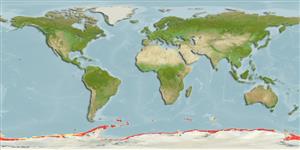Staurotheca glomulosa Peña Cantero, Svoboda & Vervoort, 1997
| Native range | All suitable habitat | Point map | Year 2050 |

|
| This map was computer-generated and has not yet been reviewed. |
| Staurotheca glomulosa AquaMaps Data sources: GBIF OBIS |
Upload your photos
Google image |
No photo available for this species.No drawings available for Sertulariidae.
Google image |
No photo available for this species.
Classification / Names Common names | Synonyms | CoL | ITIS | WoRMS
Hydrozoa | Leptothecata | Sertulariidae
Environment: milieu / climate zone / depth range / distribution range Ecology
Sessile; depth range 55 - 870 m (Ref. 7414). Polar
Distribution Countries | FAO areas | Ecosystems | Occurrences | Introductions
Antarctic: Antarctica, South Georgia and South Orkney Island.
Length at first maturity / Size / Weight / Age
Maturity: Lm ? range ? - ? cm Max length : 6.0 cm COLD male/unsexed; (Ref. 7414)
Short description Morphology
Colonies composed of masses of interwoven, usually polysiphonic stems and branches with anastomoses, up to 60mm in diameter. Hydrothecae present along whole length of colony, arranged in decussate pairs forming four longitudinal rows. Hydrothecae immersed
into branches for approximately one-third of volume. Free adcauline wall of hydrotheca one-sixth to one-tenth of its total length, straight. Abcauline wall slightly convex basally, but becoming concave distally. Hydrothecal aperture circular; rim even and usually with numerous renovations. Male and female gonothecae present. Female gonothecae typically set in a glomulus formed by a series of stolonal tubes from which the individual gonothecae
arise. Stolons also provided with isolated hydrothecae arranged in an irregular pattern; hydrothecae of glomulus smaller and with a larger part of the adcauline wall free. Gonotheca urn-shaped, with a globular basal part narrowing into a large distal neck provided with a wide distal aperture. Gonothecal wall with striae at base of neck. Female gonothecae also inserting individually at hydrothecal base. Male gonothecae not aggregated in a glomulus but arising directly at hydrothecal base. Male gonotheca fusiform, provided with a small and circular aperture at the end of a short conical neck.
Life cycle and mating behavior Maturity | Reproduction | Spawning | Eggs | Fecundity | Larvae
Members of the order Leptothecata include L-form hydroids. Life cycle: The zygote develops into planula and later into polyp then into free-swimming medusa.
Main reference
References | Coordinator | Collaborators
Peña Cantero, A.L. and W. Vervoort. 2003. (Ref. 7414)
IUCN Red List Status (Ref. 130435: Version 2024-1)
CITES status (Ref. 108899)
Not Evaluated
CMS (Ref. 116361)
Not Evaluated
Threat to humans
Harmless
Human uses
| FishSource |
Tools
More information
Trophic Ecology
Food items
Diet
Food consumption
Ration
Predators
Diet
Food consumption
Ration
Predators
Ecology
Population dynamics
Growth
Age/Size
Length-weight
Length-length
Length-frequencies
Mass conversion
Recruitment
Abundance
Age/Size
Length-weight
Length-length
Length-frequencies
Mass conversion
Recruitment
Abundance
Life cycle
Distribution
Human Related
Aquaculture profile
Stamps, Coins Misc.
Stamps, Coins Misc.
Outreach
Taxonomy
References
Internet sources
BHL | BOLD Systems | CISTI | DiscoverLife | FAO(Publication : search) | Fishipedia | GenBank (genome, nucleotide) | GloBI | Gomexsi | Google Books | Google Scholar | Google | PubMed | Tree of Life | Wikipedia (Go, Search) | Zoological Record
Estimates based on models
Preferred temperature
(Ref. 115969): -1.8 - 1.3, mean -0.7 (based on 532 cells).


